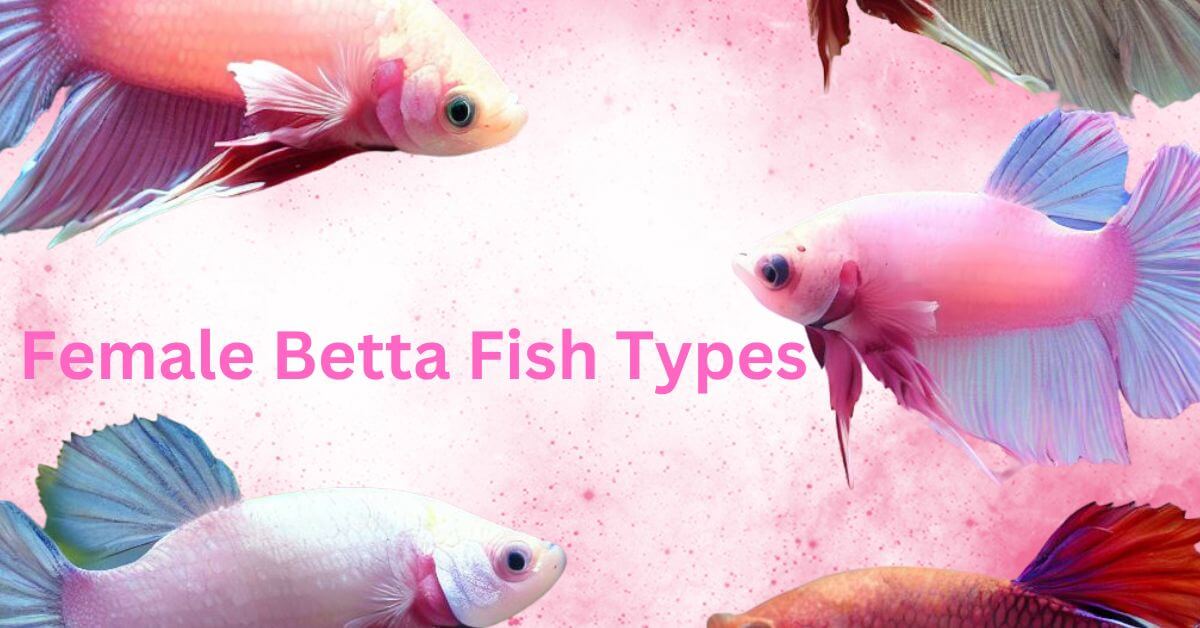Female betta fish types often don’t get as much attention as the males, but that doesn’t mean they’re any less beautiful or interesting! Just like male betta fish, female bettas are cared for by their owners, and they have their list of common types.

Betta fish are lovely, distinct, and enjoyable to keep in your home, but it might be tricky to choose the right type of female betta fish if you’re not familiar with them all.
People often keep betta fish as pets in fish tanks, and they come in various shapes and sizes.
Before we talk about the different female betta fish types, it’s important to know that all betta fish belong to one species (Betta splendens). Some experts think they might be a slightly different group within that species, while others believe they could be their own species. Regardless of how we classify them, they all have the same traits and can mix with each other.
This article will introduce you to five types of female betta fish and provide tips on how to care for each type, helping you choose the one that suits your lifestyle.
Table of Contents
Female Betta Fish: A Quick Guide
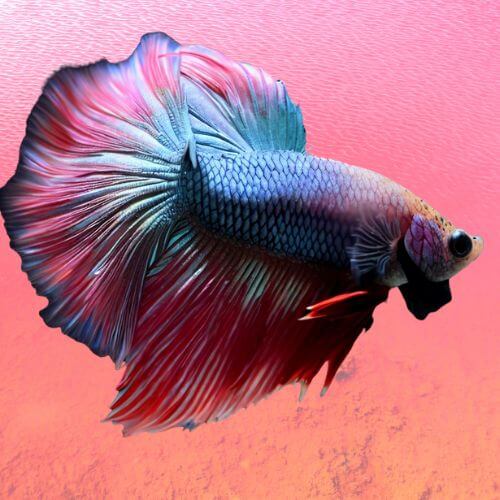
Understanding Female Betta Fish
Betta fish originally come from Thailand, Malaysia, and Cambodia. Even though the bettas in pet stores today are not exactly the same as the ones from Southeast Asia, they still share some similarities. Female bettas usually have simpler colors and characteristics. Breeders have made these differences more noticeable over time. They focused on making males more colorful with long fins and tails. However, they didn’t do the same for females.
Each type of female Betta fish has its unique markings and colors. It’s important to know that there can be many differences even within each type.
For instance, a Crowntail female Betta might have a small or big crown-like pattern on its tail. The rays on its fins could be clear or colored. Its body might have stripes and could be blue, red, or other colors. The same is true for the different types of female Betta fish. This makes them attractive to people who enjoy having new and exciting things in their fish tanks!
Female Betta Fish Size and Tank Requirements
Female betta fish are known for their elegance and usually grow to about 2.25 inches (6 cm) in size. To create a comfy home, a tank of 5-10 gallons (19-38 liters) suits their smaller size. Common female betta types need specific conditions for their well-being.
A 10-gallon tank with a secure lid, heater, and air filter is ideal. Adding gravel, rocks, or marbles as hiding spots makes them happy. These social fish thrive with their kind and compatible tank mates. Use a filter to keep them healthy by preventing harmful ammonia buildup.
How to Tell if a Betta Fish is Female?
To differentiate female betta fish, look for their smaller fins compared to males, along with a slightly smaller and slimmer body. They are less colorful and have an egg spot. When placed side by side, distinguishing between male and female bettas is quite simple. However, it’s more challenging to tell them apart before they mature.
Female Betta Fish Behavior and Care
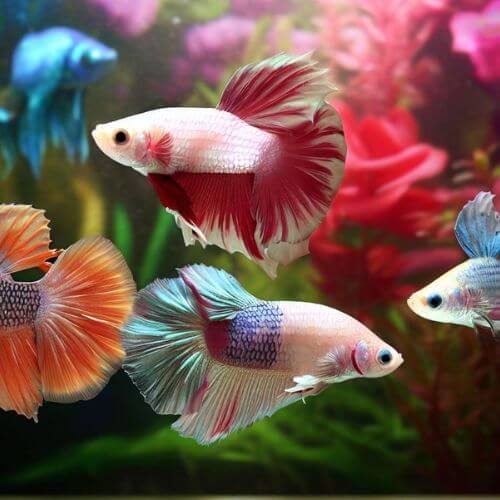
Female betta fish have a friendly nature and get along well with other fish, unlike male bettas who can be aggressive. This makes them perfect for community tanks, where they can live happily with other fish that match their temperament.
Egg Laying and Breeding Behavior
Female betta fish lay eggs after mating with a male. To breed bettas, move both the male and female to a separate tank. The male cares for the eggs until they hatch, showing surprising parenting skills. Identifying the “egg spot” under the female’s body helps tell male and female bettas apart. This spot is where eggs are laid, noticeable before fin differences show.
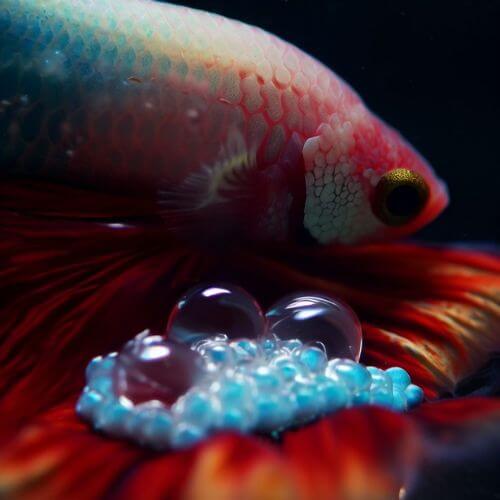
Creating and Managing a Sorority Tank
A sorority includes four to six female bettas of similar age. Provide ample space, avoiding tanks under 20 gallons to prevent aggression due to crowding. Observe your sorority closely, as not all females suit this setup. A social hierarchy forms, requiring patience. Keep a cycled spare tank in case separation is needed.
Understanding Behavior
Female bettas are less aggressive than males but still display territorial behavior. Remember, all bettas have aggressive tendencies. Sororities need time to adjust and establish social order. Some females are too bold for group settings. Monitor your fish closely, particularly after moving to a new tank, which can cause stress and lead to aggression.
Choosing the Right Tank Mates for Female Betta Fish
When considering tank mates for your female betta fish, it’s essential to make wise choices due to their territorial nature. While females are generally less aggressive than males, they can still engage in fights, especially with fish of similar colors. To ensure a harmonious tank, opt for neutral or differently colored fish with a similar body type. For instance, an Oscar fish might be a better companion for a Betta splendens than another betta.
To maintain peace, consider bottom-dwelling fish that are less likely to disturb your female betta. Suitable options include:
- Pygmy cory
- Yoyo loach
- Clown pleco
- Clown loach
- Panda cory
Swimming and shoaling species can also work well, as they prevent aggressive females from targeting a specific fish. Examples of such species are:
- Penguin tetra
- Gold tetra
- Pristella tetra
- Red Eye Tetra
- Mosquito rasbora
- Black phantom tetra
- Blue tetra
Other compatible tank mates include Rosy Barbs, Zebra Danios, Swordtails, White Cloud Mountain Minnows, Neon Tetras, and Mollies.
What Makes Female Bettas Unique?
While male bettas are renowned for their long, flowing fins and territorial behavior, female bettas exhibit a different charm altogether. They possess shorter fins, but their elegant forms and captivating colors make them a wonderful addition to any aquarium community.
Female Betta Fish Colors and Types

How do Female Assorted Bettas Look?
A female assorted betta is a colorful fish for tanks, but it’s usually kept alone because of its aggressiveness. Owners often prefer separate tanks for female bettas due to their aggressive behavior when together. Despite their beauty, female betta fish are charming.
- CTPK = Crowntail Plakat
- HM = Half Moon
- BF = Butterfly
- HMPK = Half Moon Plakat
- PK = Plakat
A Traditional Yellow Dragon is a kind of betta with shorter fins. It’s sometimes referred to as a short-finned fighter due to its short fins.
These fish are bred in certain regions for fighting purposes. Male varieties of this kind have a distinctive gill beard below the chin and are usually thicker and more significant.
Female Betta Fish Types
1. Female Veil Tail (VT)
Veiltail bettas are the most common type, seen in both males and females. Female veiltails have vibrant colors like males, but their fins are shorter. They come in various colors due to breeding. Patterns like dragon, butterfly, and marble can be found in females as well.

2. Female Marble Betta/Koi Betta (HMPK)
Koi bettas are known for their unique marbled pattern in colors like red, white, gold, black, and orange. Female koi bettas resemble males but have shorter fins and tails. Among betta types, koi and veiltail bettas are the easiest to care for.
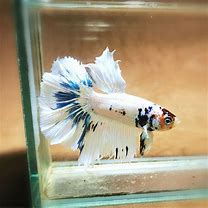
3. Female Halfmoon Betta (HM)
Female halfmoon bettas come in a variety of colors and patterns, similar to their male counterparts. However, their tail fins, while not as impressive as the males, still have a nice 180-degree shape.

4. Female Delta Tail Betta (DT)
The Delta Tail female betta is a distinct variety of female Siamese fighting fish. They sport a distinctive appearance, featuring a slim and elongated body shape. Their smaller heads come with pointed beards, which sets them apart from other Siamese fighting fish types. Notably, their fan-shaped tails stand in contrast to the eel-like tail fins commonly found in their male counterparts.
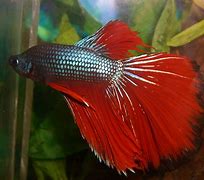
5. Female Crowntail (CT)
The crowntail betta boasts a unique tail resembling a majestic crown. Despite the female’s less vibrant colors compared to the male, spotting this fish is a truly spectacular sight. Known for their dancing and swift movements, these bettas bring energy to the tank.
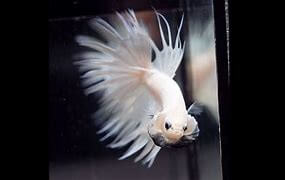
However, it’s important to note that this variety tends to be more aggressive than others. Maintaining a suitable environment can help manage their aggression. Genetic factors can also influence their behavior. Ensuring pristine water conditions is essential for the well-being of your crowntail betta.
6. Female Plakat Betta (PK)
The plakat betta fish is among the top five popular female betta types. Plakats are long-finned bettas, also called plakat bettas or plakats. They have large, flowing fins and are active swimmers.

Named for their resemblance to male bettas but without a showy tail fin. They have smaller bodies compared to other female types like veiltails or crown tails, yet sport longer fins. Great for those desiring an active, smaller betta that won’t occupy too much tank space.
7. Female Half Sun Betta (HF)
The Half Sun Fish is not the opposite of the Halfmoon Betta Fish, despite the name. Its distinct shape makes it a popular choice in the market. When exposed to light, this fish showcases a fringe of rays on its tail, adding to its stunning appearance.

In terms of personality, the Half Sun Fish can be aggressive, especially among females. Its appearance might seem odd as its fins appear united, giving it a tailless look. The coloration of the Half Sun Fish typically includes a combination of at least two colors, making it a truly unique and captivating addition to any aquarium.
Betta Feeding & Health Facts

Diet Variety: Bettas are carnivores and enjoy foods like flakes, bloodworms, and shrimp pellets. Optimal nutrition comes from a mix of brine shrimp, tubifex worms, and daphnia.
Lifespan: Under proper care, female bettas can live up to 3 years in captivity.
Health Challenges: Despite their beauty, bettas face diseases like fin rot, tail rot, and swim bladder issues. Parasites, including anchor worms and flukes, can also affect them. A common concern is pop-eye, where their eyes bulge due to clogged tear ducts, causing discomfort.
Disease Management: While some diseases are treatable, others can be fatal. Tank conditions, space, and proper care can prevent diseases. Maintain ideal temperature, water quality, and nutrition for a healthy female betta fish.
Natural Predators: In the wild, bettas live in ponds, exposing them to predators like snakes, otters, and birds. In captivity, ensure peaceful tankmates to keep your betta safe and stress-free.
In summary, providing a diverse diet, maintaining health through proper care, and ensuring a safe environment are key to fostering the well-being of female betta fish.
FAQs
1. Can female bettas be kept together in the same tank?
Female bettas can live together in a “sorority tank,” but it needs to be at least 20 gallons with hiding spots and plants to reduce aggression. Put all the females in at once to prevent fights. Keep an eye on them, and if they fight too much, separate the aggressive ones for their safety.
2. What is the best tank size for female bettas?
The best tank size for female bettas is typically a tank of at least 10 gallons. This provides enough space for them to swim and ensures they have a comfortable and healthy living environment.
3. How can I encourage my female betta to display her full fin spread?
You can help your female betta fish show off her beautiful fins by keeping her in a clean tank with good water quality and the right temperature. She needs a balanced diet and friendly tankmates. Boost her confidence and encourage fin displays by adding hiding spots and plants. A happy and healthy betta is more likely to flaunt her fins.
4. Do female bettas have the same vibrant colors as males?
Female bettas usually aren’t as colorful as males. Male bettas have bold and bright colors to impress mates and mark territory. Females, in contrast, tend to have more muted and less flashy colors. Although they can still have different shades and patterns, their colors are generally not as vivid as males
5. Can I breed female bettas like I do with males?
you can breed female bettas, but it’s different from breeding males. Unlike males, females don’t create bubble nests. To breed females, introduce a compatible male to a well-prepared tank with hiding spots. Watch their behavior; when the male wraps around the female, she releases eggs. The male fertilizes them as they fall. Afterward, remove the female to prevent aggression. Raising the fry needs special care. Breeding female bettas is possible, but you must understand their unique behaviors and requirements compared to males.

